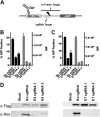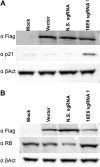Inactivation of the human papillomavirus E6 or E7 gene in cervical carcinoma cells by using a bacterial CRISPR/Cas RNA-guided endonuclease
- PMID: 25100830
- PMCID: PMC4178730
- DOI: 10.1128/JVI.01879-14
Inactivation of the human papillomavirus E6 or E7 gene in cervical carcinoma cells by using a bacterial CRISPR/Cas RNA-guided endonuclease
Abstract
High-risk human papillomaviruses (HPVs), including HPV-16 and HPV-18, are the causative agents of cervical carcinomas and are linked to several other tumors of the anogenital and oropharyngeal regions. The majority of HPV-induced tumors contain integrated copies of the normally episomal HPV genome that invariably retain intact forms of the two HPV oncogenes E6 and E7. E6 induces degradation of the cellular tumor suppressor p53, while E7 destabilizes the retinoblastoma (Rb) protein. Previous work has shown that loss of E6 function in cervical cancer cells induces p53 expression as well as downstream effectors that induce apoptosis and cell cycle arrest. Similarly, loss of E7 allows increased Rb expression, leading to cell cycle arrest and senescence. Here, we demonstrate that expression of a bacterial Cas9 RNA-guided endonuclease, together with single guide RNAs (sgRNAs) specific for E6 or E7, is able to induce cleavage of the HPV genome, resulting in the introduction of inactivating deletion and insertion mutations into the E6 or E7 gene. This results in the induction of p53 or Rb, leading to cell cycle arrest and eventual cell death. Both HPV-16- and HPV-18-transformed cells were found to be responsive to targeted HPV genome-specific DNA cleavage. These data provide a proof of principle for the idea that vector-delivered Cas9/sgRNA combinations could represent effective treatment modalities for HPV-induced cancers. Importance: Human papillomaviruses (HPVs) are the causative agents of almost all cervical carcinomas and many other tumors, including many head and neck cancers. In these cancer cells, the HPV DNA genome is integrated into the cellular genome, where it expresses high levels of two viral oncogenes, called E6 and E7, that are required for cancer cell growth and viability. Here, we demonstrate that the recently described bacterial CRISPR/Cas RNA-guided endonuclease can be reprogrammed to target and destroy the E6 or E7 gene in cervical carcinoma cells transformed by HPV, resulting in cell cycle arrest, leading to cancer cell death. We propose that viral vectors designed to deliver E6- and/or E7-specific CRISPR/Cas to tumor cells could represent a novel and highly effective tool to treat and eliminate HPV-induced cancers.
Copyright © 2014, American Society for Microbiology. All Rights Reserved.
Figures






Similar articles
-
In vitro and in vivo growth inhibition of human cervical cancer cells via human papillomavirus E6/E7 mRNAs' cleavage by CRISPR/Cas13a system.Antiviral Res. 2020 Jun;178:104794. doi: 10.1016/j.antiviral.2020.104794. Epub 2020 Apr 14. Antiviral Res. 2020. PMID: 32298665
-
Repression of human papillomavirus oncogenes in HeLa cervical carcinoma cells causes the orderly reactivation of dormant tumor suppressor pathways.Proc Natl Acad Sci U S A. 2000 Nov 7;97(23):12513-8. doi: 10.1073/pnas.97.23.12513. Proc Natl Acad Sci U S A. 2000. PMID: 11070078 Free PMC article.
-
High-Risk Alphapapillomavirus Oncogenes Impair the Homologous Recombination Pathway.J Virol. 2017 Sep 27;91(20):e01084-17. doi: 10.1128/JVI.01084-17. Print 2017 Oct 15. J Virol. 2017. PMID: 28768872 Free PMC article.
-
Genomic Signatures in HPV-Associated Tumors.Viruses. 2021 Oct 5;13(10):1998. doi: 10.3390/v13101998. Viruses. 2021. PMID: 34696429 Free PMC article. Review.
-
Molecular mechanism of carcinogenesis by human papillomavirus-16.J Dermatol. 2000 Feb;27(2):73-86. doi: 10.1111/j.1346-8138.2000.tb02126.x. J Dermatol. 2000. PMID: 10721654 Review.
Cited by
-
The power and the promise of CRISPR/Cas9 genome editing for clinical application with gene therapy.J Adv Res. 2022 Sep;40:135-152. doi: 10.1016/j.jare.2021.11.018. Epub 2021 Dec 4. J Adv Res. 2022. PMID: 36100322 Free PMC article. Review.
-
Effects of HPV Pseudotype Virus in Cutting E6 Gene Selectively in SiHa Cells.Curr Med Sci. 2018 Apr;38(2):212-221. doi: 10.1007/s11596-018-1868-3. Epub 2018 Apr 30. Curr Med Sci. 2018. PMID: 30074178
-
Targeting HPV16 DNA using CRISPR/Cas inhibits anal cancer growth in vivo.Future Virol. 2018 Jul;13(7):475-482. doi: 10.2217/fvl-2018-0010. Epub 2018 Jun 12. Future Virol. 2018. PMID: 30245733 Free PMC article.
-
[Precision screening and treatment of human papilloma virus related cervical cancer].Zhejiang Da Xue Xue Bao Yi Xue Ban. 2018 Feb 25;47(4):338-343. doi: 10.3785/j.issn.1008-9292.2018.08.02. Zhejiang Da Xue Xue Bao Yi Xue Ban. 2018. PMID: 30511518 Free PMC article. Review. Chinese.
-
CRISPR/Cas9-mediated cervical cancer treatment targeting human papillomavirus E6.Oncol Lett. 2019 Feb;17(2):2197-2206. doi: 10.3892/ol.2018.9815. Epub 2018 Dec 10. Oncol Lett. 2019. PMID: 30675284 Free PMC article.
References
-
- Howley PM. 1991. Role of the human papillomaviruses in human cancer. Cancer Res. 51:5019s–5022s - PubMed
MeSH terms
Substances
Grants and funding
LinkOut - more resources
Full Text Sources
Other Literature Sources
Medical
Research Materials
Miscellaneous

